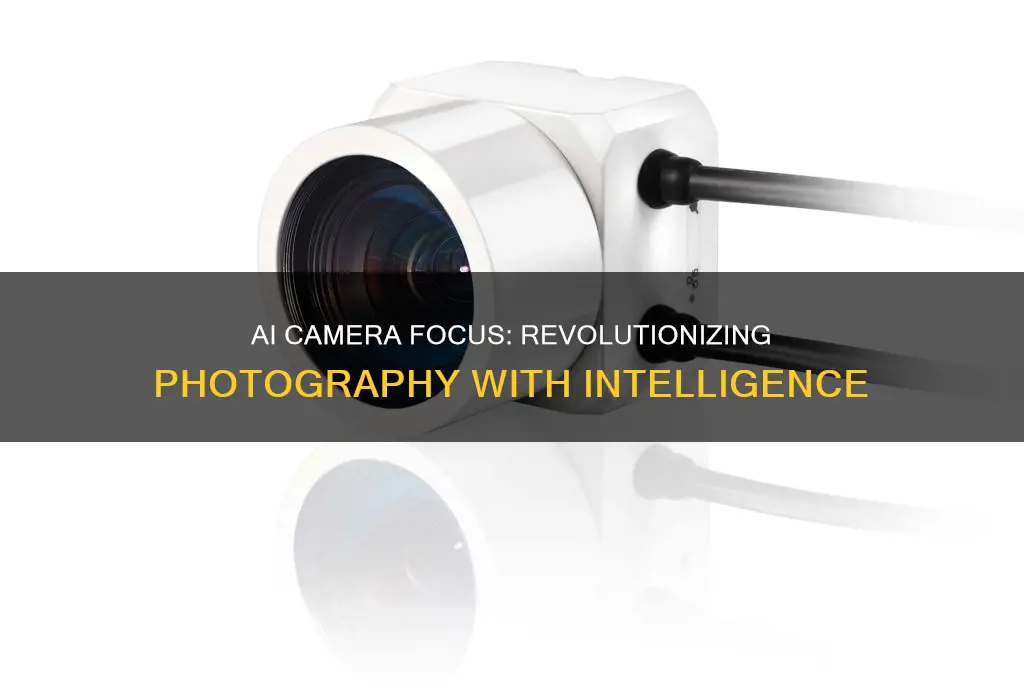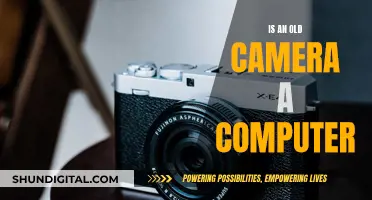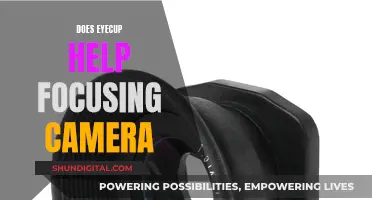
AI Focus is an autofocus mode that assumes that the subject of a photograph is still, with the knowledge that it might move. AI Servo, on the other hand, is an autofocus mode that is used when the subject is constantly moving. AI Focus AF is automatically set in the < > mode. AI Servo AF is Canon's version of continuous-servo autofocus, which is useful for tracking moving subjects and focusing at a shallow depth.
| Characteristics | Values |
|---|---|
| Purpose | To allow the camera to decide whether to use AI Servo AF or One Shot Focus |
| Activation | When the shutter button is half-pressed |
| Still subjects | Chooses One Shot Autofocus |
| Moving subjects | Uses AI Servo AF |
| Camera models | Canon EOS 7D Mark II, Sony a7R V |
What You'll Learn

AI Focus vs AI Servo
AI Focus and AI Servo are autofocus modes available on Canon cameras. The main difference between the two is that AI Focus AF assumes that the subject is mainly still, while AI Servo AF is used when the subject is constantly moving.
AI Focus AF is best used when shooting subjects that are still but may begin to move. For example, when taking portraits of children, they are expected to stay still, but they may move. AI Focus AF is also useful for wildlife photography when photographing an animal at rest.
AI Servo AF is more suitable for action shots or when the subject is in constant motion. For instance, when taking pictures of children playing or running, they will be constantly moving, so AI Servo AF is recommended. It is also useful for wildlife photography when capturing animals in motion, such as running, flying, or jumping.
AI Focus AF initially locks focus on the subject when the shutter button is half-pressed. If the subject is still, it chooses One Shot Autofocus. However, if the subject starts to move, it switches to AI Servo AF and begins tracking the subject.
AI Servo AF, on the other hand, does not lock focus. When the shutter button is half-pressed, it starts focusing and continuously adjusts the focus in anticipation of the subject's movement. It predicts the subject's movements and can be further configured using AI Servo presets to make more accurate predictions.
While AI Focus AF is useful when there is a possibility of the subject moving, AI Servo AF is more reactive to moving subjects as it anticipates their movements. AI Servo AF is also more accurate when the subject is in constant motion as it can quickly change the autofocus point.
Bosch Cameras: Where Are They Manufactured?
You may want to see also

Canon's AI Servo AF
AI Servo AF is designed for capturing moving subjects. When the shutter button is pressed halfway, the camera will continuously focus on the subject without locking focus. This is in contrast to One-Shot AF, which is designed for still subjects and will lock focus when the shutter button is pressed halfway.
AI Servo AF is also predictive, anticipating the movement of the subject. This is achieved through a set of AI Servo presets, which can be selected to make a more accurate prediction. These presets are found inside the AF Configuration Tool and are designed for different types of movement. For example, Case 1 is a multi-purpose mode that will change focus if another subject comes into the foreground, while Case 4 keeps the original subject in focus even if it moves towards or away from the camera at different speeds.
The AI Servo AF mode also offers additional configuration options, including tracking sensitivity, acceleration/deceleration tracking, and auto-focus point switching. Tracking sensitivity determines whether the autofocus system prioritises the original subject or objects that come into the foreground. Acceleration/deceleration tracking sets how responsive the camera is to changes in the speed of moving objects. Finally, auto-focus point switching determines how quickly the camera will change from one autofocus point to another, which is useful for subjects that make fast and erratic moves.
In summary, Canon's AI Servo AF is a useful autofocus mode for capturing moving subjects. It offers several configuration options to optimise the camera's predictive capabilities and ensure that the subject remains in focus.
The Olympus OM-1 35mm Camera: A Vintage Photography Icon
You may want to see also

Sony's AI autofocus
Sony has incorporated AI autofocus into its camera systems, enhancing the accuracy, precision, and efficiency of shooting. The AI chip in Sony's A6700 and A7R V cameras is a notable example of this innovation.
The AI autofocus system in the Sony A6700, priced at $1,399, is adapted from the company's high-end A7R V model, which costs $3,900. This AI-powered autofocus system can detect and distinguish various subjects, including different types of animals, insects, vehicles, and even planes. It also offers 334 more phase-detect autofocus points and AI-based auto-framing, enabling it to track moving subjects without the need for manual camera adjustments.
The Sony A7R V, a 61-megapixel full-frame mirrorless camera, also showcases the power of AI autofocus. It features an AI processing unit chip that enhances autofocus performance and improves white balance accuracy. The AI capabilities enable the camera to include insect priority autofocus and provide more advanced tracking features in video modes.
The inclusion of AI in Sony's autofocus systems offers significant benefits to photographers and videographers. It improves the overall shooting experience by ensuring fast and accurate focus, allowing users to capture sharp and well-defined images. This technology also grants creative freedom, as photographers can achieve desired effects, such as shallow depth of field or selective focus, more effortlessly.
While Sony has made significant strides in AI autofocus technology, it is not the only company exploring this domain. Canon, for instance, has also incorporated AI autofocus in its cameras, such as the Canon 1D Mark 2 with AI Servo autofocus. However, Sony's AI autofocus system seems to go beyond, offering more advanced subject detection capabilities.
Converting to Black and White: Camera Raw Techniques
You may want to see also

Manual focus vs autofocus
AI Focus is an autofocus mode that uses artificial intelligence to determine whether to use AI Servo AF or One Shot Focus. When the shutter button is half-pressed, it locks focus on the subject. If the subject is still, it chooses One Shot Autofocus. If the subject is moving, it will use AI Servo AF.
Now, when it comes to manual focus vs autofocus, there are several factors to consider. Autofocus allows the camera to set the focal point, handling most of the work in ensuring a clear shot. It is generally quick, though its speed depends on the camera and lens type. Sports-oriented equipment, for example, is typically faster. Autofocus has also seen advancements such as tracking, which enables it to lock focus on a subject and track it through the frame. This is especially useful for capturing moving subjects.
Manual focus, on the other hand, enables the user to set the focal point, providing more creative control over the image. It is ideal for situations where autofocus may struggle, such as low light conditions, shooting through glass or fences, or when there are many objects in the scene. It is also more precise, allowing you to carefully pick your point of focus from a chaotic scene.
In conclusion, neither autofocus nor manual focus is universally superior. The choice depends on the photographer's needs and shooting conditions. Autofocus is generally recommended as the default, with manual focus used in specific scenarios where autofocus struggles.
Testing Camera Focus: Tips for Sharp Photography
You may want to see also

Autofocus area modes
Single-Point AF Area Mode
Single-Point AF allows the photographer to select a single focus point, usually via a multi-selector button, to focus on a stationary subject. This mode is ideal for situations where the photographer can follow the subject through the viewfinder, as the camera will only focus on what is within the selected point. It is well-suited for portrait, landscape, and architecture photography, where precise focus on a specific area is crucial.
Dynamic AF Area Mode
Dynamic AF Area Mode is a versatile tool for capturing moving subjects. The photographer selects an initial focus point, and if the subject moves, the camera automatically uses the surrounding focus points to maintain focus. The number of surrounding points used can vary, with options like 9, 21, or 51 points available on some cameras. This mode is excellent for wildlife, sports, and action photography, where subjects may move erratically.
3D Tracking AF Area Mode
3D Tracking is an advanced autofocus area mode that uses algorithms to track and follow a moving subject. It measures the distance between the subject and the camera for accurate focus locking. Additionally, this mode uses predictive focus tracking, anticipating the subject's future position to ensure sharp focus when the shutter is released. 3D Tracking works best when there are distinct differences in colour and contrast between the subject and the background.
Auto-Area AF Mode
Auto-Area AF is a fully automatic mode where the camera decides which focus points to use based on factors like subject distance, motion, and the presence of detectable eyes. This mode is useful for novice photographers or situations where the photographer needs to focus on something quickly. However, it offers less control over the specific focus point.
Group AF Area Mode
Group AF area mode is ideal for photographing groups of subjects, such as wildlife or sports teams, where multiple subjects are in the same zone. The photographer selects a specific autofocus area with a small number of autofocus points, ensuring accuracy when a single AF point is not sufficient. This mode is also useful for portrait photography when capturing a group of people.
Best Batteries for Your XSH Camera Doorbell
You may want to see also
Frequently asked questions
AI Focus is an autofocus mode that assumes your subject is still but may start moving. It allows the camera to decide whether to use AI Servo AF or One Shot Focus.
When the shutter button is half-pressed, the camera locks focus on the subject. If the subject is still, it chooses One Shot Autofocus. If the subject is moving, it will use AI Servo AF.
AI Focus is best if you're shooting subjects that are still but may start moving. For example, children's portraits or wildlife photography.
AI Focus assumes that the subject is mainly still, while AI Servo assumes that the subject is constantly moving. AI Servo is more reactive to moving subjects as it anticipates their movements.







